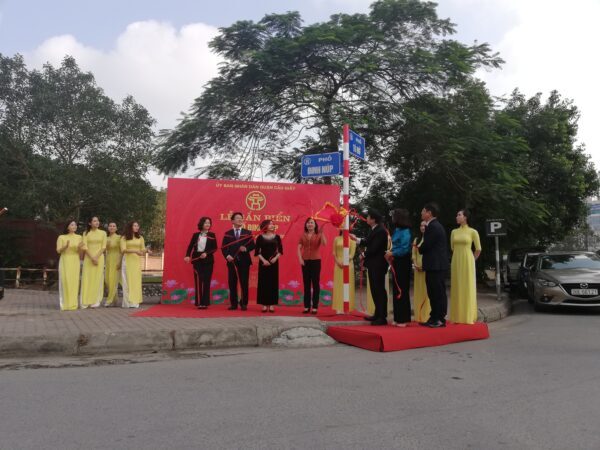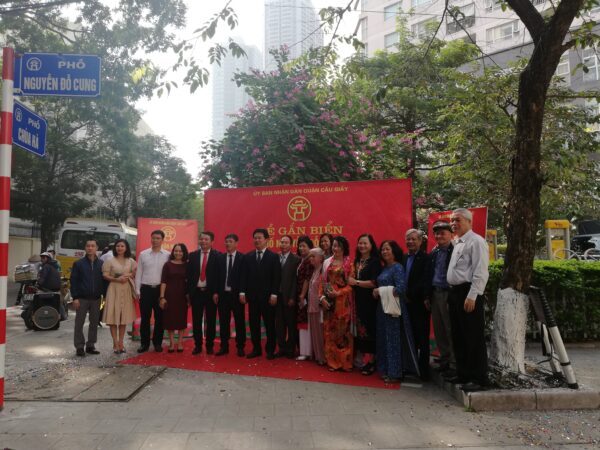
The ceremony to attach Dinh Nup street nameplate
Dinh Nup Street is named for the section from the intersection of Nguyen Chanh Street at Plot A5 and Plot A7 to the intersection of Tu Mo Street at the opposite point of CT4 Vimeco apartment building. The street is 1,000m long, 20.5m wide, sidewalks on each side are 5m.
Dinh Nup, also known as Sar (1914-1999) is a Ba Na ethnicity, from Stor village, KBang district, Gia Lai province. He participated in the revolution since 1935, who built the anti-French movement for ethnic minorities in the Central Highlands. He mobilized ethnic minorities to join guerrilla groups, build villages to fight against the raids of the French army, consuming many enemy forces. After the Genève Convention, he and his unit gathered to the North, then returned to fight against the American army in the Central Highlands. In 1955, he was admitted to the Communist Party of Vietnam. In 1963, he entered the southern battlefield. In 1964, he visited the Republic of Cuba at the invitation of President Fidel Castro. He used to hold various positions: Chairman of Gia Lai Fatherland Front Committee – Kontum (1976), Member of the 6th National Assembly (1976 – 1981), Member of Standing Committee of the 6th National Assembly (1976 -1981). He was awarded the title of Hero of the People’s Armed Forces (in 1955), the Ho Chi Minh Badge, the Third Military Medal, and the First Victory Medal. He is the main character, the prototype in the novel “Dat nuoc dung len” by writer Nguyen Ngoc, which has been made into a movie. His image is considered a symbol of the heroic will of Vietnam, the power of great national unity. His name has been given to several roads and some schools in Phu Yen, Dak Lak and Da Nang provinces.
Nguyen Xuan Linh Street is located for the section from the intersection of Tran Duy Hung Street at No. 115 to the intersection of Le Van Luong Street at Golden Place Building. The street has a length of 720m, a width of 17.5m, sidewalks of 3.5m on each side.
Nguyen Xuan Linh (1909 – 1988) was born in a patriotic Confucian family of Nam Quang village, Nam Dan district, Nghe An province. He had aliases Nam, Xuan, Cung, Hai .. in 1925, he joined the struggle movement of the Phuc Viet to demand the release of Phan Boi Chau, and then joined the rally, protest, and commemoration of Phan Chu Trinh. He was admitted to the first class Party in Nghe Tinh in 1930, he actively participated in propaganda and revolutionary campaign, many times captured by the enemy and released from prison. In 1932, he participated in establishing Vinh – Ben Thuy Party Committee and was elected as Secretary of the Party Committee, later he was Secretary of Ha Tinh Provincial Party Committee in two periods: 1951-1954 and 1959-1972. During this time, he directly directed Ha Tinh Party Committee and people to fight against the French army and the US army; devise plans for socio-economic development, strengthen national defence, and make significant historical achievements of Ha Tinh. In 1972, he was elected to the Standing Committee of the National Assembly. He has been awarded the Gold Star Medal, Ho Chi Minh Medal and many other noble medals. In Nghe An province, there was a road named after him.

The Ceremony to attach Nguyen Do Cung street nameplate
Nguyen Do Cung Street is located for the section from the intersection of Nguyen Phong Sac Street at No. 76 to the intersection of Chua Ha Street at the opposite point of Dich Vong Secondary School’s back gate. The street is 500m long, 12.5m wide, sidewalks of 2.75m on each side.
Nguyen Do Cung (1912-1977) was born in Xuan Tao Ward, Bac Tu Liem district, Hanoi. He graduated from the 5th course of Indochina Fine Arts College with Nguyen Gia Tri, Tran Binh Loc … After the August Revolution, Nguyen Do Cung was one of the three artists who entered the Presidential Palace directly to paint and sculpt Uncle Ho. When the whole country resistance, he volunteered to join the Southward march. In 1947, he was Chairman of the Inter-Regional Resistance Cultural Federation V. Here, he opened many short-term painting classes, with new training methods, he contributed to the training of new generations of artists. Many have become famous painters. He paints not much, but each work is a great work, marking a long step with each painting trend. He was the first director of the Fine Arts Research Institute, who also contributed in building the Vietnam Fine Arts Museum. In 1976, he completed the oil painting “Tan ca” – one of the beautiful and typical works of his writing career. This work won the first prize at the National Fine Arts Exhibition in 1976 and is kept in the Vietnam Fine Arts Museum. He was a Member of the First National Assembly. He was awarded the First-Class Labor Medal, the Third-class Resistance Medal, and the Ho Chi Minh Prize for Literature and Art of the first phase in 1996.
The addition of 3 new streets named is the honor of the Party Committee, authorities and People in Cau Giay District in particular and Hanoi Capital in general. Thereby, confirming the responsibility of the Party leaders and authorities at all levels in the management and preservation of traditional cultural values in modern life today. The People’s Committee of Cau Giay District proposed the Fatherland Front Committee and other socio-political organizations, related departments, branches and leaders of the People’s Committee of the ward with a new street named Trung Hoa, Yen Hoa and Dich Vong to strengthen the public propaganda about the identity, career, labor and contributions of three famous people to all classes of people; continue to pay attention to directing and mobilizing the people to perform urban embellishment, maintain security and order, clean the environment, take care of the increasingly tidy, clean and civilized street worthy of a street named after celebrities who have made great contributions to the nation’s history and the development of the country.
Minh Hue

